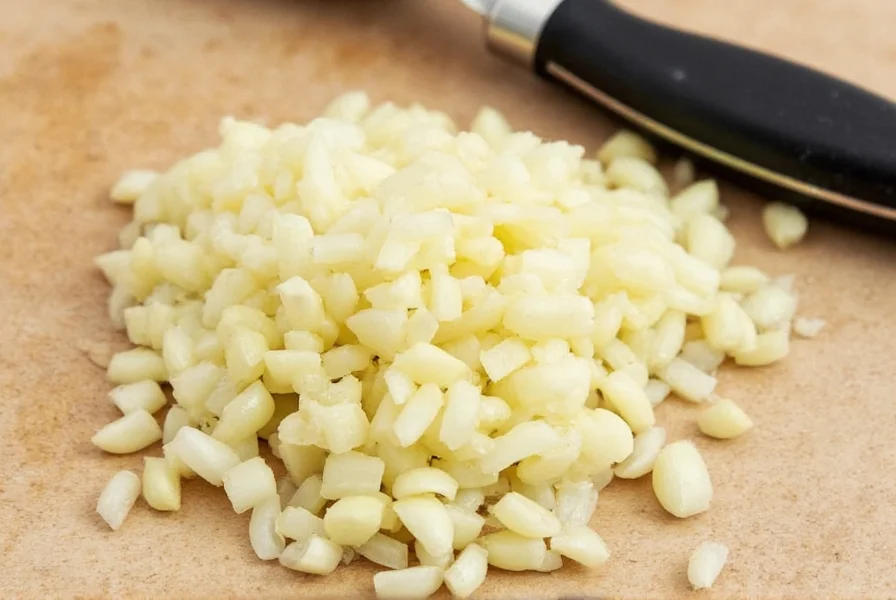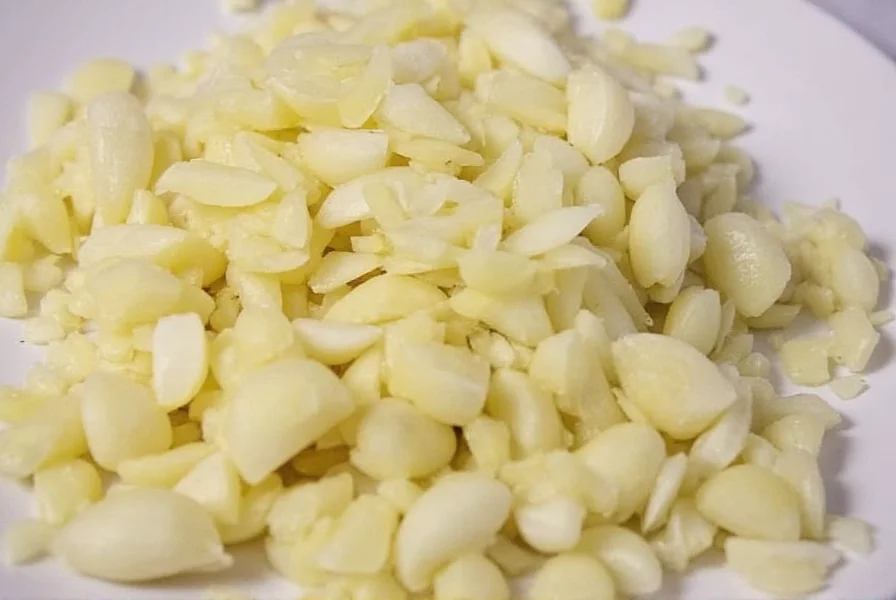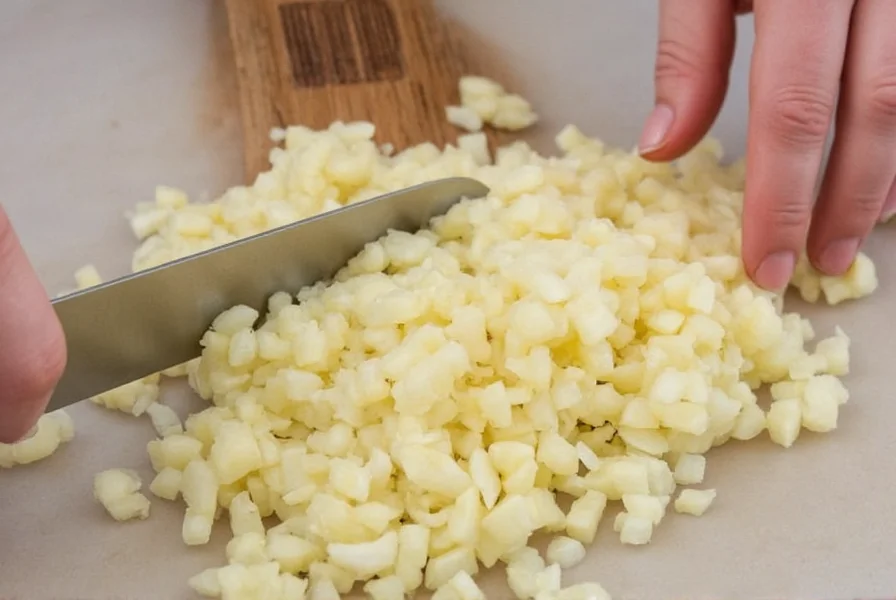Understanding the precise minced garlic to clove ratio is essential for achieving consistent flavor in your cooking. When recipes call for specific measurements of minced garlic but you're working with whole cloves, knowing this conversion prevents guesswork and ensures your dishes turn out perfectly every time.
Standard Minced Garlic Conversion Guide
The minced garlic to clove ratio depends primarily on the size of the garlic cloves you're using. While measurements can vary slightly, professional chefs and culinary experts generally agree on these standard conversions:
| Garlic Clove Size | Whole Cloves | Minced Garlic Equivalent |
|---|---|---|
| Small | 1 clove | 1/4 teaspoon (1.25 ml) |
| Medium (standard) | 1 clove | 1/2 teaspoon (2.5 ml) |
| Large | 1 clove | 3/4 teaspoon (3.75 ml) |
| Extra Large | 1 clove | 1 teaspoon (5 ml) |
Factors Affecting Minced Garlic Measurements
Several variables influence the minced garlic to clove ratio in practical cooking situations:
Clove Size Variations
Garlic cloves vary significantly in size depending on the variety and growing conditions. A single head of garlic typically contains cloves ranging from small inner pieces to larger outer cloves. When precision matters, consider sorting cloves by size before mincing.
Mincing Technique
Your mincing method impacts the final volume. Finely minced garlic packed tightly into a measuring spoon yields more concentrated flavor than loosely packed coarsely minced garlic. For the most accurate minced garlic equivalent to one clove, use a consistent mincing technique throughout your recipe.

When Precision Matters in Recipes
Certain dishes require careful attention to the garlic clove to minced garlic conversion:
- Delicate sauces and dressings - Where garlic flavor can dominate if overused
- Pickling and preserving - Precise measurements affect preservation chemistry
- Baking with savory elements - Such as garlic bread or herb focaccia
- International cuisines - Where garlic proportions define authentic flavor profiles
For most everyday cooking, slight variations in the minced garlic measurement per clove won't dramatically affect results. However, when developing recipes or cooking for others with specific taste preferences, accurate conversion becomes more important.
Practical Substitution Tips
When converting between whole cloves and minced garlic in recipes, keep these practical considerations in mind:
- For recipes calling for 3 or more cloves, the cumulative effect of size variations becomes more significant
- Freshly minced garlic has a brighter, more complex flavor than pre-minced jarred garlic
- When using jarred minced garlic, reduce the amount by 25% as it often contains preservatives that alter potency
- Roasted garlic yields less volume when minced compared to raw garlic
Common Measurement Mistakes to Avoid
Cooks frequently encounter these issues when working with the garlic clove to minced garlic ratio:
- Assuming all cloves are equal - Heads contain varying clove sizes
- Not accounting for moisture content - Freshly minced garlic contains water that affects volume
- Using heaping versus level measurements - Consistency matters for accurate substitution
- Ignoring recipe context - Some dishes benefit from garlic's texture, not just flavor

Advanced Considerations for Culinary Precision
Professional chefs often take additional factors into account when converting garlic cloves to minced garlic:
The age of garlic affects its moisture content and density. Older garlic heads tend to produce drier cloves that yield slightly less minced volume. Additionally, the curing process impacts how much minced garlic you'll get from each clove. For critical applications like recipe development or catering, weighing garlic provides the most accurate conversion—approximately 3 grams of minced garlic per medium clove.
Understanding these nuances helps explain why some recipes specify "about" when giving minced garlic measurements. The natural variability in fresh ingredients is part of what makes cooking both challenging and rewarding.
How much jarred minced garlic equals one fresh clove?
When substituting jarred minced garlic for fresh, use approximately 1/2 teaspoon per medium clove, but reduce the amount by 25% compared to fresh minced garlic. Jarred garlic often contains preservatives and has a slightly different potency, so start with less and adjust to taste.
Does roasting garlic change the minced garlic to clove ratio?
Yes, roasting garlic reduces its volume by approximately 20-25% due to moisture loss. One medium roasted garlic clove yields about 3/8 teaspoon of minced roasted garlic compared to the standard 1/2 teaspoon for raw garlic. The flavor also becomes sweeter and less pungent.
Can I use garlic powder instead of minced garlic?
Yes, but the conversion differs significantly. As a general rule, 1/8 teaspoon of garlic powder equals one medium garlic clove. Garlic powder is more concentrated, so use about 1/6 the amount you would of fresh minced garlic. Remember that powder lacks the moisture and fresh flavor notes of minced garlic.
Why does my minced garlic measurement vary from recipe to recipe?
Variations occur due to differences in clove size, mincing technique, and how tightly the garlic is packed into the measuring spoon. Recipe developers may also have different interpretations of "medium" cloves. For consistency, consider weighing your garlic (approximately 3g per medium clove) or standardizing your mincing technique.
How can I quickly mince garlic without a press?
Peel the clove and lay it flat on your cutting board. Place the flat side of a chef's knife over the garlic, then press down firmly with the heel of your hand to crush it. Rock the knife back and forth to mince finely. Sprinkling a pinch of salt on the garlic before mincing helps break it down more easily and prevents sticking.











 浙公网安备
33010002000092号
浙公网安备
33010002000092号 浙B2-20120091-4
浙B2-20120091-4